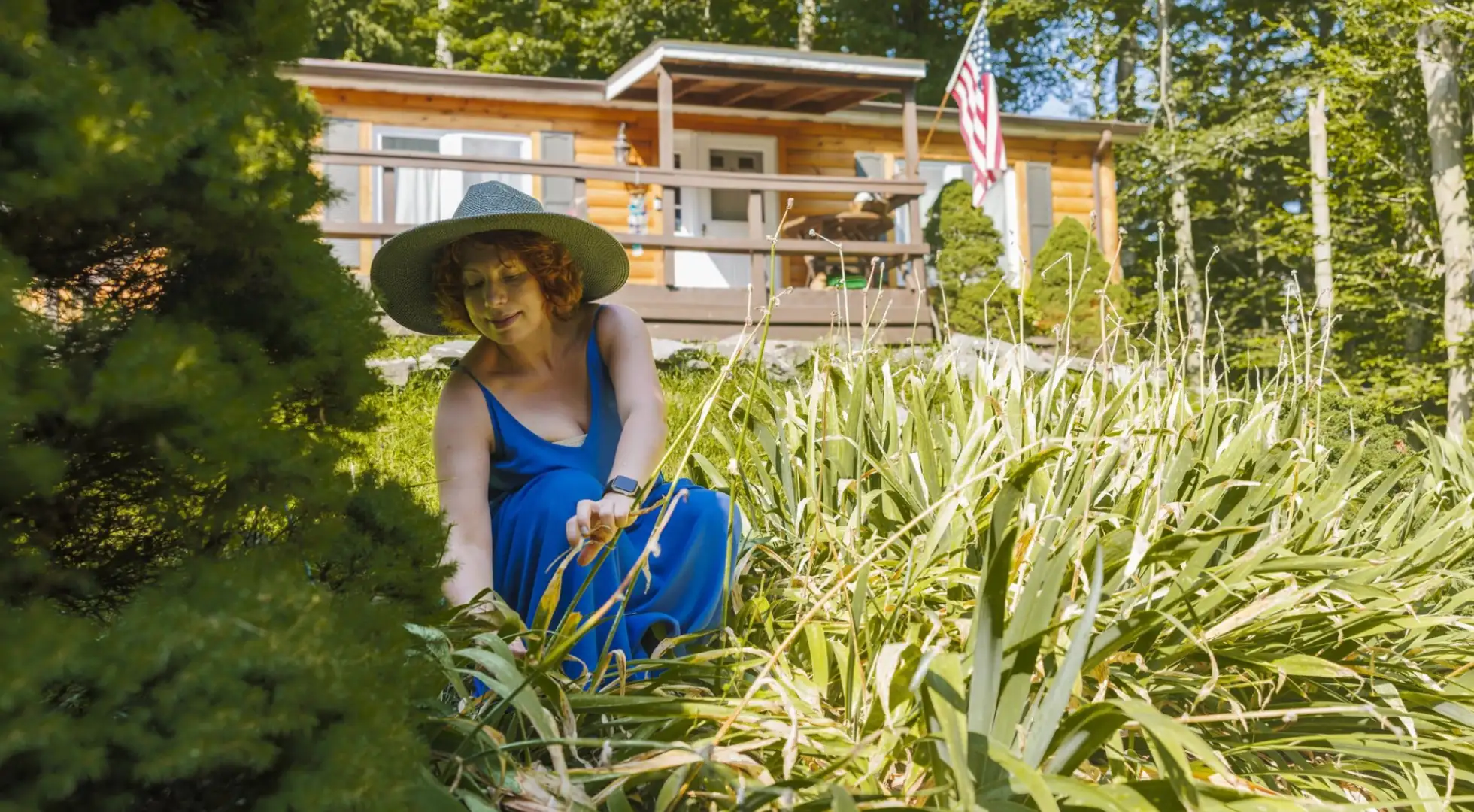Can You Buy a Manufactured Home with a USDA Loan?

USDA loans offer the opportunity to buy a manufactured home with zero down. But it must be a new, never-lived-in manufactured home to be eligible.
Eager to purchase a starter home but lack the down payment funds? Consider applying for a USDA home loan, which requires no down payment and may come with a lower interest rate than other mortgage loan types. One of the easiest and most inexpensive ways to enter homeownership is to purchase a manufactured home. The good news is that you can get a USDA loan for manufactured homes if you qualify.
Understanding USDA Loans
The USDA home loan offers up to 100% financing, meaning no down payment is required. Low- and moderate-income individuals who plan to live in a USDA-eligible area may be able to take advantage of the program to buy a home.
Borrowers also benefit from typically lower interest rates than other types of mortgage loans. USDA program fees, called “guarantee fees” are typically less than FHA mortgage insurance.
This loan can be used to buy an existing home, make home improvements, move a home, or even build a new one. One of the program's key advantages is that it’s not limited to first-time homebuyers, providing a great opportunity for many people and families seeking affordable housing options. To qualify, you must commit to living in the home as your primary residence and meet local median income guidelines (your income cannot exceed 115% of the median household income).
A USDA loan can be used to purchase a single-family home, condo, townhome, or even a manufactured home.
Check out our full guide to USDA loan requirements to learn more.
Defining Manufactured Homes
A manufactured home is a residence that was constructed in a factory after June 15, 1976, and then moved to a permanent location (on a permanent foundation). The home must adhere to Federal Manufactured Home Construction and Safety Standards (FMHCSS) set by HUD.
“A manufactured home differs from a mobile home, which is typically built before June 15, 1976, and may not meet current safety standards,” explains Carl Holman with A&D Mortgage, who adds that you cannot use a USDA loan for mobile home financing.
“Manufactured homes are also distinct from modular homes, which are built to local building codes rather than HUD standards. For a USDA loan, the manufactured home must display a HUD certification label and meet all requirements for permanent installation.”
Pros and Cons of Using USDA Loans for Manufactured Homes
Again, USDA loans provide several perks to eligible borrowers.

"No down payment is ever required, which is a considerable advantage for buyers with low and moderate incomes. What’s more, the interest rate charged will likely be lower than you’d pay for a conventional loan."
In addition, the program accommodates individuals with less-than-perfect credit scores. Consider that the USDA doesn’t set a minimum credit score threshold for this loan, although many lenders require a score of at least 640.
“And USDA loans are aimed at helping people purchase homes in rural areas, so they’re a great fit for folks looking to settle down in less-populated regions,” says Martin Boonzayer, CEO of The Trusted Home Buyer.
However, there are some drawbacks to USDA loans. As mentioned, you’ll need to meet USDA income requirements, the home has to be your primary residence, and you cannot live in a city or densely populated location. In addition, while you won’t have to pay for mortgage insurance, you will be on the hook for a one-time guarantee fee, paid upfront, that typically equates to 1% of your loan amount; you also have to pay an annual guarantee fee that calculates to 0.35% of your loan amount.
These costs are less expensive than FHA’s 1.75% upfront fee and typical ongoing fee of 0.55% per year.
Common Misconceptions and Challenges
Many misunderstandings exist around USDA loans, and some borrowers underestimate the costs and responsibilities.
“One misconception is that these loans are only for traditional single-family homes. But actually, they can also finance manufactured homes if the criteria are met,” Holman notes.
Boonzayer points out that many people mistakenly think USDA loans are only for low-income buyers.
“But the income limits vary by location, so it’s worth checking – even if you are not considered ‘low-income’ by the usual standards,” he says.
Another myth? USDA loans cover all types of manufactured homes.
“Actually, they are generally limited to new units,” says Steven Glick, director of mortgage sales for HomeAbroad.
A common challenge is finding eligible homes and lots in rural areas that meet USDA standards. Also, the requirement for a permanent foundation can add upfront costs. And the process involved can take a bit longer than it would for a typical home loan because there are more paperwork and approval steps involved.
“Appraisal complications make for an added hurdle, in that manufactured housing will have less value and fewer appraisers will make site evaluations, creating an added difficulty in processing the loan,” cautions Morgado.
Related: USDA Loan Appraisal Requirements: What to Expect
Eligibility Criteria for USDA Loans on Manufactured Homes
Here’s what’s needed for a manufactured home to qualify for a USDA loan.
Property Requirements
New construction: The home must be new, built within the last 12 months, and never previously installed or occupied.
Permanent foundation: It must be affixed to a permanent foundation that complies with HUD guidelines.
Size: “Single-wide manufactured homes should be at least 12 feet wide with a minimum of 400 square feet of living space. Double-wide homes must be at least 20 feet wide,” notes Glick.
HUD certification: Every section of the manufactured home must display a red certification label indicating compliance with HUD standards.
Site Requirements
Location: The property must be located in a USDA-eligible rural area.
Real estate classification: The structure must be classified and taxable as real estate. “It has to be considered real estate, not just personal property – meaning you own the land it sits on,” says Boonzayer.
Utilities: “The site needs to have basic utilities like water, sewage, and electricity, and the home must be your primary residence,” Boonzayer adds.
Borrower Requirements
Income limits: Your household income must not exceed 115% of the median income for the area you are purchasing in.
Qualifying Income: You must meet USDA debt-to-income ratio guidelines, meaning the lender deems your income adequate to cover the house payment and all existing debts.
Credit score: Lenders typically require a score of at least 640, although the USDA does not set a minimum credit score.
Primary residence: The home must be used as your primary residence. “You can’t use a USDA loan to purchase a vacation or rental property,” continues Boonzayer.
How It Works: Buying Land or Using Land You Own, Site Prep, and Transporting the Home
Because USDA loans can only be used for manufactured homes that are new, there are several other factors to consider, including how to acquire the land, how to finance both the home and land if necessary, how to finance site preparation if required, and more.
In summary, USDA loans can be used to finance:
The purchase of the manufactured home
Purchasing the land to put it on (if needed)
Delivery and setup costs
“Fortunately, USDA loans can be used to purchase both the manufactured home and the land it will occupy,” says Glick. “The USDA’s Single Family Housing Guaranteed Loan Program offers a combination construction-to-permanent loan, which allows financing for the purchase of land, construction costs, and the manufactured home itself – all bundled into a single loan.”
Note that this program requires that the manufactured home be new, transported directly from the manufacturer to the site, and installed on a permanent foundation. Additionally, the property must be located in a USDA-eligible rural area. Also, the unit must comply with HUD’s Federal Manufactured Home Construction and Safety Standards. Homes on temporary or non-permanent foundations are ineligible, as are used or previously occupied manufacturer homes.
“To find land for a manufactured home with a USDA loan, start by using the USDA eligibility map to ensure the land is in an eligible rural area,” recommends Glick. “Also, work with a real estate agent familiar with USDA loans to locate land zoned for residential use.”
If you already own your own land, you can use it – so long as it is in a USDA-eligible area. The value of the land can be included in your loan, and if your land is owned outright it may serve as a down payment.
When it comes to the land itself, the site must be prepared to accommodate a permanent foundation. The property must have access to adequate water and wastewater disposal systems. The site must also meet current floodplain requirements, ensuring the finish grade beneath the home or the habitable floor is above the 100-year floodplain. Additionally, the site must be zoned for residential use and meet all local zoning requirements.
“It’s important to work with lending professionals who know USDA loan nuances and manufactured home requirements, which can really smooth out the process,” Boonzayer says.
Where to Find USDA Manufactured Home Construction Lenders
Wondering how and where to locate a participating lender who can provide financing for your manufactured home and site? Thankfully, the USDA provides an updated list of lenders currently offering USDA’s Single-Close Construction-to-Permanent loan program. Click here to access the list.
“Work with a USDA-approved lender who knows this process. Not all lenders finance land plus a manufactured home, and finding out too late can cost you time,” cautions Glick. “Also remember that the budget for land preparation isn’t always covered in your home’s price
The Application Process for a USDA Manufactured Home Loan
It’s important to know what’s involved with applying for a USDA loan when you want to purchase a manufactured home. Here’s a breakdown:
Shop around: Find an approved lender that specializes in USDA loans.
Get prequalified: Discuss your financial situation with a USDA-approved lender to determine your eligibility.
Get preapproved: Submit the necessary documentation, including credit history and income verification, to get preapproved, and receive a preapproval letter.
Find the manufactured home: Find a USDA-qualified manufactured home builder/dealer
Find the site: Locate land in a USDA-eligible rural area that meets all site requirements. The manufactured home builder/dealer may also offer a site you can purchase.
Agree to purchase: Enter into a purchase agreement for both the home and the land.
Prepare the site: The site must be prepared to accommodate a permanent foundation, have access to adequate water and wastewater disposal systems, and meet all HUD standards. The site must also be zoned for residential use and meet current floodplain requirements.
Have the property appraised and inspected: Your lender will order an appraisal to ensure the property’s value and condition meet USDA standards. It’s also smart to have the manufactured home inspected by a professional, which is not required but strongly recommended.
Await an underwriting decision: Your lender will review your complete loan file and issue an approval decision if you pass muster.
Close on the home: After approval, prepare to sign documents and finalize the purchase at closing.
Move the manufactured home: Have the new manufactured home moved to your purchased site, affixing it to a permanent foundation.
Alternative Financing Options
A USDA loan isn’t your only choice if you want to purchase a manufactured residence. Instead, look into these alternatives:
FHA loans: The Federal Housing Administration offers loans for manufactured homes, often with more lenient credit requirements.
VA loans: Eligible veterans can access loans for manufactured homes via the Department of Veterans Affairs, although you’ll need to be a veteran, active-duty military member, or surviving spouse to qualify.
Chattel loans: “These are personal property loans that finance the home itself but not the land. They often come with higher interest rates and shorter terms,” Glick points out.
Conventional loans: “Some banks will offer loans for manufactured homes, although these often have stricter requirements,” Boonzayer says.
Maintenance and Resale Considerations
Manufactured homes will need regular maintenance and upkeep to remain in good condition. That means you’ll need to keep a close eye on things like the roof, foundation, plumbing, HVAC system, and other components so that you stay compliant with local codes.
“Proper skirting and ventilation of your manufactured home are also crucial to avoid moisture-related damage,” suggests Holman.
Note that insurance costs are commonly higher for manufactured homes than traditional residences due to increased weather-related risks.
“If you are thinking about resale, keep in mind that manufactured homes tend to lose value faster than traditional homes – so you might not sell it for as much as you paid for it,” warns Boonzayer. “However, if the home is well-maintained, meets HUD standards, and is in a good location, it can still sell fairly well.”
Conclusion
USDA loans offer an accessible homeownership opportunity for qualifying low- and moderate-income buyers, providing full financing with no down payment for properties in eligible rural areas. While the application process may take longer and involve specific property criteria, USDA loans remain a strong option for those looking for affordable housing in less populated regions.
Take the time to research manufactured homes and locations thoroughly before committing to a purchase. And choose a real estate agent and lender experienced with manufactured homes and USDA loans to ensure a smoother process.








